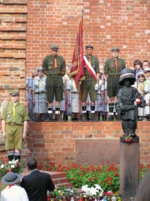Boy Scouts
|
|
Boy Scouts originally denoted the organization that developed and rapidly grew up during 1908 in the wake of the publication by Lord Robert Baden-Powell of his book Scouting for Boys. A Boy Scout originally referred to a male youth between the age of 12 and 17 who participated in the program. The program was soon expanded to involve younger children as Cub Scouts, age 8 to 11. Today, many national scouting programs also have a program for young children aged 6 to 8 years. There is also a young-adult program aimed at 18 to 25-year-olds. This program was originally called Rovering but now goes under various names as established by national Scouting organizations.
At the first national scout gathering held in the United Kingdom, Baden-Powell discovered that there were a significant number of girls involved in the movement. He and his sister formed a parallel organization for girls called the Girl Guides.
Each national scouting organization that belongs to the World Organization of the Scout Movement decides whether its program will be for boys only or will be coeducational. The World Association of Girl Guides and Girl Scouts is the parallel scouting organization for girls in Scouting.
The history of and further information on Boy Scouts is contained in the main article on Scouting.


